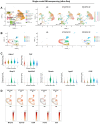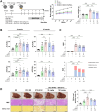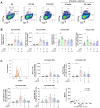Chitinase 1: a novel therapeutic target in metabolic dysfunction-associated steatohepatitis
- PMID: 39381000
- PMCID: PMC11459552
- DOI: 10.3389/fimmu.2024.1444100
Chitinase 1: a novel therapeutic target in metabolic dysfunction-associated steatohepatitis
Abstract
Background: Metabolic dysfunction-associated steatohepatitis (MASH) is characterized by persistent inflammatory cascades, with macrophage activation playing a pivotal role. Chitinase 1 (CHIT1), produced by activated macrophages, is a key player in this cascade. In this study, we aimed to explore the role of CHIT1 in MASH with progressive liver fibrosis.
Methods: Fibrotic liver tissue and serum from distinct patient groups were analyzed using nCounter MAX, flow cytometry, immunohistochemistry, and enzyme-linked immunosorbent assay. A MASH mouse model was constructed to evaluate the effectiveness of OATD-01, a chitinase inhibitor. Macrophage profiling was performed using single-nuclei RNA sequencing and flow cytometry.
Results: CHIT1 expression in fibrotic liver tissues was significantly correlated with the extent of liver fibrosis, macrophages, and inflammation. Single-nuclei RNA sequencing demonstrated a notable increase in macrophages numbers, particularly of lipid-associated macrophages, in MASH mice. Treatment with OATD-01 reduced non-alcoholic fatty liver disease activity score and Sirius red-positive area. Additionally, OATD-01-treated mice had lower CHIT1, F4/80, and α-smooth muscle actin positivity, as well as significantly lower levels of inflammatory markers, pro-fibrotic genes, and matrix remodeling-related mRNAs than vehicle-treated mice. Although the population of F4/80+CD11b+ intrahepatic mononuclear phagocytes remained unchanged, their infiltration and activation (CHIT1+MerTK+) significantly decreased in OATD-01-treated mice, compared with that observed in vehicle-treated mice.
Conclusions: Our study underscores the pivotal role of CHIT1 in MASH. The observed significant improvement in inflammation and hepatic fibrosis, particularly at higher doses of the CHIT1 inhibitor, strongly suggests the potential of CHIT1 as a therapeutic target in MASH accompanied by progressive liver fibrosis.
Keywords: MASH mouse mod; chitinase 1; inflammation; metabolic dysfunction-associated steatohepatitis; mononuclear phagocyte.
Copyright © 2024 Cha, Park, Cho, Nam, Yang, Jung, Jang, Choi, Yoon, Sung and Bae.
Conflict of interest statement
The authors declare that the research was conducted in the absence of any commercial or financial relationships that could be construed as a potential conflict of interest.
Figures





References
MeSH terms
Substances
LinkOut - more resources
Full Text Sources
Molecular Biology Databases
Research Materials
Miscellaneous

